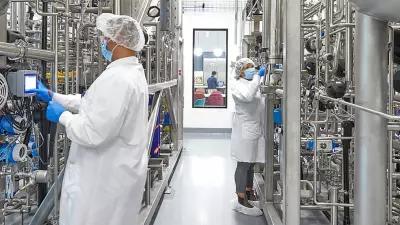Whether the chicken or the egg came first is fast becoming moot with the advent of cultivated meat.

Dozens of start-ups are exploring the possibilities, making chicken, beef, pork and even seafood in processes that range from coaxing stem cells to manipulating embryonic tissue to create the foods we are used to seeing on restaurant plates and in grocery store meat cases.
The product is grown in a nutrient-rich environment and is seen by many as a means of easing food shortages around the globe as well as reducing the impact of agriculture on the environment.
The U.S. Food and Drug Administration and the U.S. Department of Agriculture have been working with some of these companies to set standards, and the first of those approved for human consumption have been unveiled with great fanfare at premier restaurants.
The first cultivated meat product was sold by JUST Foods in 2020: chicken nuggets at a Singapore restaurant. The very first offering, a burger, was produced in 2013 by Professor Mark Post and his team at Maastricht University.
This summer UPSIDE Foods unveiled its chicken breast at Bar Crenn restaurant in San Francisco.
“It was amazing,” Amy Chen, UPSIDE’s chief operating officer, told Postindustrial. “This has the potential to transform one of the largest industries in the world. Cultivated meat offers the ability to bring the meat people love to the table in a more environmentally friendly way.”
Founded in 2017, Aleph Farms of Rehovot, Israel, is producing a thin-cut beef steak from cells taken from a non-GMO cow named Lucy.
“Our distinctive technology involves an initial focus on growing animal proteins and fats from cells sourced from cattle,” CEO and co-founder Didier Toubia told Postindustrial, adding the company chose to work on beef because that would make the greatest environmental impact.
“We aspire not to replace conventional animal products produced from raising whole animals, but rather, to complement sustainable livestock agriculture as a new category of animal products …” — Didier Toubia, CEO and co-founder of Aleph
Aleph’s technology was even tested on the International Space Station under a program dubbed Aleph Zero, with the goal of providing fresh meat for long space missions. Growing the cuts takes four to six weeks, compared with 16 to 32 months through conventional methods.
Chen describes UPSIDE’s chicken breast, which is produced from fibroblasts taken from chicken embryos, as succulent, with the texture of white meat and a taste closer to dark meat, but without the higher fat and calorie content. UPSIDE’s breasts take two to three weeks to produce, compared to two to three months conventionally, depending on the breed of the bird.
For Bar Crenn’s meal, Chef Dominique Crenn fried the UPSIDE chicken in a spicy tempura batter, but Chen said the product can be treated like any other piece of boneless chicken, so sautéing, baking and broiling also are on the menu.
Dane Chauvel, CEO of Organic Ocean Seafood, told Postindustrial he sees cultivated seafood as complementary to current methods of harvesting seafood but says current scientific efforts are focused on the wrong things.
“It’s a cool idea. We should be doing it,” said Chauvel, who is on an advisory board for a start-up he declined to identify. “I take issue with the current focus on culturing in-lab products like salmon. That’s not the best business approach.
“I would look at those species that are extremely high value and have sustainability issues, like bluefin tuna. We have some sustainable sources, but very few. If you could create a bluefin tuna proxy through this production method, it would be very cool. It would address market and sustainability issues for a high-value protein. I would want to work on those things with the highest price point.”
The consensus appears to be that cultivated meat could easethe environmental impact and help meet the growing demand for high-quality protein worldwide.
“We aspire not to replace conventional animal products produced from raising whole animals, but rather, to complement sustainable livestock agriculture as a new category of animal products, with the intent of diversifying and decentralizing sources of animal proteins and fats. This is central to our purpose,” Toubia said.

The USDA estimated 2022 meat consumption would reach a level second only to the peak reached in 2021. Per capita, Americans had access to 224.6 pounds of red meat and poultry.
Global meat consumption increased 58% between 1998 and 2018, reaching 360 million tons. Population growth accounted for 54% of the increase, the Australian government said.
“Rising incomes are a major driver of increased meat consumption. Between 1990 and 2018 higher real GDP per person coincided with higher rates of meat consumption. However, the impact that rising income has on meat consumption slows considerably as countries develop,” the Australian Department of Agriculture, Fisheries and Forestry said in a report. “Per person consumption in China and Indonesia increased markedly with small increases in income over the period. In contrast, Australian and U.S. meat consumption was much less sensitive to income growth.
“Japan is an exception to the correlation between consumption and income. Per person meat consumption in Japan has fallen considerably since 1990 despite rising incomes. This reflects an aging population that is reducing overall expenditure on food.”
But it’s unlikely much cultivated meat will be available to consumers anytime soon, largely due to costs and scalability. Neither Chen nor Toubia revealed how much it costs to produce their products.
“We’re operating on the assumption it’s scalable and economically competitive,” Chauvel said. “[But] it does have promise. … My sense is it’s not far away. I think once you’ve got the science down, the species is less of a constraint. I think it will be fairly commonplace within five years.”
“We hope to launch in Singapore and Israel later this year,” Toubia said, pending regulatory approvals. “We’ll launch Aleph Cuts in limited quantities through curation of unique tasting experiences with select partners. It might take beyond 2023 for our products to reach the mainstream market in the form of widespread sales in restaurants and supermarkets,” Toubia said, adding, the company is taking steps to achieve price parity with conventional beef within a few years.
“My sense is it’s not far away. I think once you’ve got the science down, the species is less of a constraint. I think it will be fairly commonplace within five years.” — Dane Chauvel, CEO of Organic Ocean Seafood
A technical analysis by Ark Biotech found its bioreactors could reduce the cost of producing cultivated meat products to $29.50 per pound.The Good Food Institute said it is working with agencies around the world to develop regulatory oversight and has a grant program to further research.
In a 2021 report, the U.S. Environmental Protection Agency blamed agriculture for 10% of greenhouse gas emissions, singling out meat production as responsible for more than half that percentage. USDA statistics show at least 40% of agricultural land is devoted to raising livestock.
Unlike Chauvel, the National Cattlemen’s Beef Association (NCBA) is not happy about the prospects of cultivated meat and said there still are many questions surrounding the product.
“Foremost among those questions is whether there is significant consumer demand for these highly processed products, which have been unable to compete with naturally produced protein sources. Beef producers have always supported a consumer’s right to choose, and we’re willing to meet any competitor on a level playing field,” Lane said in an email.
In 2021, the NCBA told the USDA lab-grown meat should not be labeled “meat.”
“Meat is explicitly defined in the Code of Federal Regulations, the definition of which hinges entirely on the source of the product. Meat, as defined by the CFR, is the muscle of an animal. Lab-grown protein companies claim that their products give consumers the opportunity to consume a protein product that does not come directly from an animal but is rather grown from animal cells. Such a product can, at best, be classified as a meat byproduct or meat food product,” NCBA said in its filing.
The labeling also raises interesting questions when it comes to religious certification bodies, specifically those responsible for kosher and halal seals of approval.
Both the Jewish and Muslim traditions have strict rules on how animals are slaughtered and what constitutes a kosher or halal animal, as well as what parts of the animal are acceptable. Under kashrut, the rules governing what Jews can and cannot eat and how some foods can be prepared, Jews are not supposed to mix meat with dairy products.

But if meat is grown in a lab, is it meat?
In Israel Ashkenazi Chief Rabbi David Lau reasoned cultivated meat would be kosher if taken from a kosher animal – that rules out pork and shellfish, among other things – but is not so sure it should be labeled meat, saying it is neither dairy nor meat. Whether that means Jews could legally eat cheeseburgers made with cultivated meat would depend on whether the lab-grown food is marketed as meat.
“On the one hand, if the product we eat was never part of a living animal, then it isn’t meat,” Rabbi David Niven, who wrote an analysis for the Rabbinic Assembly, told Postindustrial. “Indeed, halakhah [Jewish law] has some odd cases where ‘meat’ is pareve — for example, a calf found in a slaughtered cow. And it also has cases where eggs are considered meaty, for example, when found in a slaughtered chicken. These two cases contradict each other — confusing!
“On the other hand, if the product has the very same substance of meat taken from a live animal, then it would be confusing to treat it as pareve.”
Halal has no strictures on food pairings and certification bodies have issued no definitive comment on whether cultivated meat meets religious standards.
Several professors at the College of Sharia and Islamic Studies at Kuwait University in Kuwait said, however, cultivated meat could be halal as long as the production process does not involve substances like blood, blood serum or plasma, The Halal Times reported last year.
Despite the possibility of these products being considered non-meat, vegetarians may not jump at the opportunity to add cultivated meat to their diets.
Nancy Friedman of Skokie, Illinois, told Postindustrial that over time, she developed a “genuine ethical aversion to the whole notion of ingesting the dead flesh of another creature.”
She added: “And what, you may ask, does this have to do with not eating lab-grown meat, which was never a living creature at all? By now, my aversion to eating flesh is so strong and so complete that I do not want to eat anything that resembles animal flesh, or in the case of lab-grown meat, aspires to be animal flesh. For example: The Beyond Meat [plant-based] products have no appeal to me. I have no interest in (or appetite for) eating a ‘fake meat’ burger that is bloody by design!”







